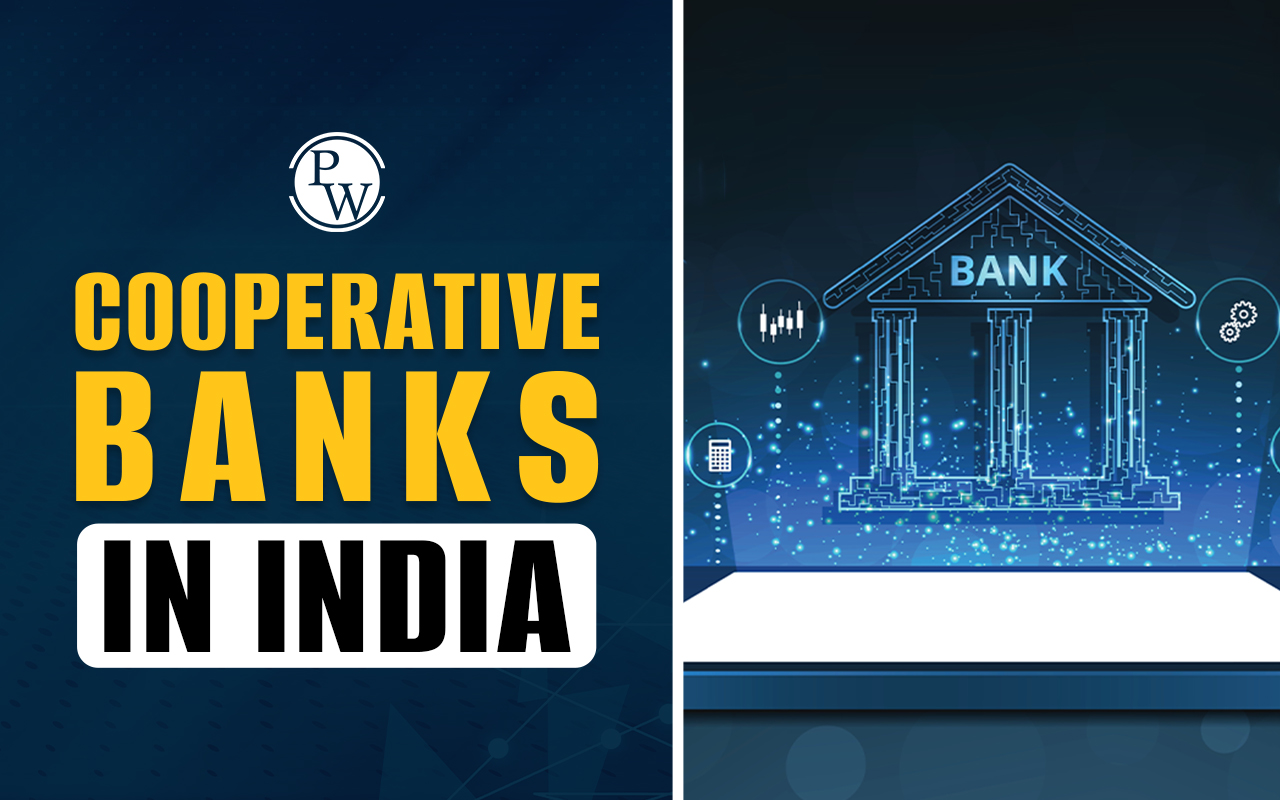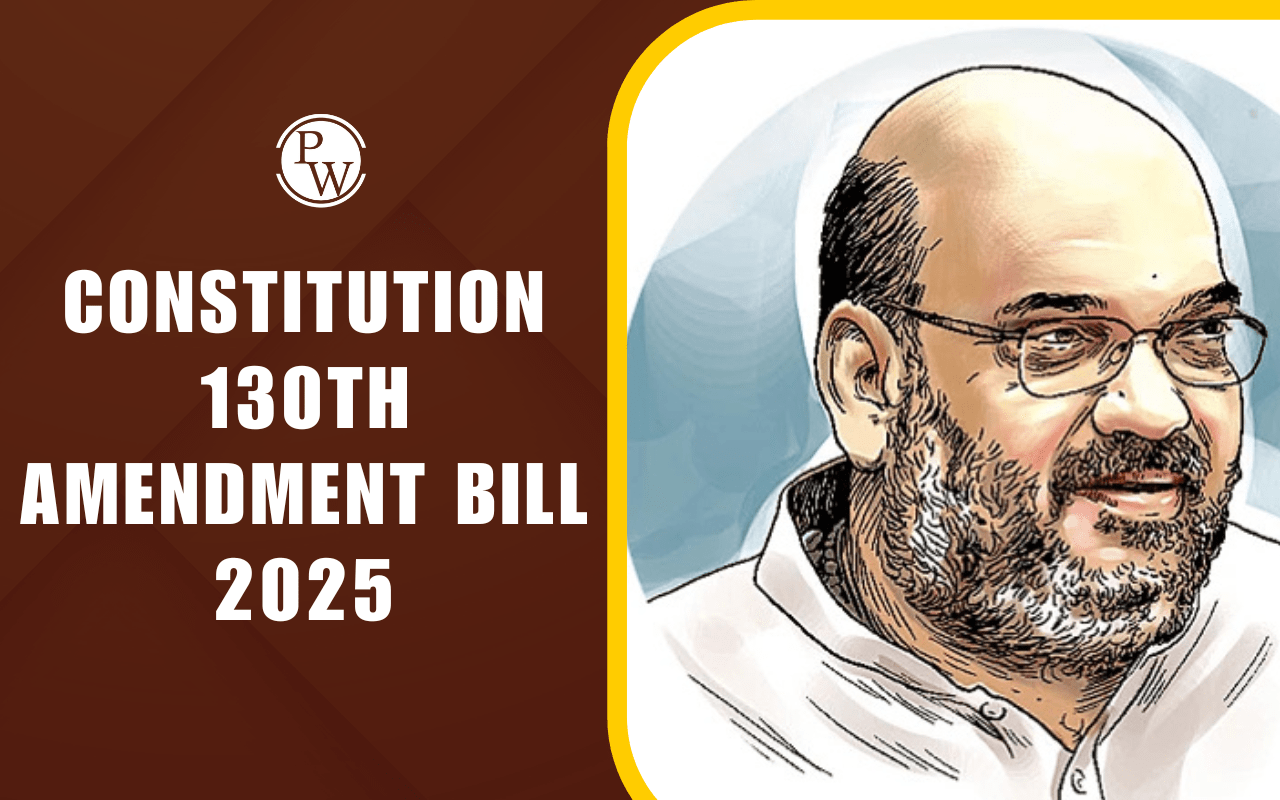

Economic Survey 2024 : The Economic Survey 2024 has been tabled in Parliament by Union Finance Minister Nirmala Sitharaman on July 22, 2024 . The Economic Survey of India 2023-24 along with a statistical appendix was presented a day ahead of the ‘Union Budget 2024’. This survey of the Indian economy has been prepared by the Department of Economic Affairs under Chief Economic Adviser, V. Anantha Nageswaran.
This year, both the Economic Survey 2023–24 and the Union Budget 2024 have been delayed due to the general election. The Economic Survey 2024 preface discusses ' Steering the country through compacts and consensus' . The Economic Survey 2024 holds significant importance in the Civil Services Examination , and therefore, aspirants must download and read it thoroughly. A direct download of the Economic Survey PDF 2024 is available here.Economic Survey 2024 PDF
The Economic Survey 2024 PDF is now available for download on the official website of the Ministry of Finance. PW ONLYIAS experts will analyze the Economic Survey 2024 data and discussion and release a comprehensive PDF for the UPSC Exam 2024. The Economic Survey 2023–24 PDF Download Link is active here for UPSC aspirants:Economic Survey 2024
It is important to know what an economic survey is. The Economic Survey is an annual document presented by the Ministry of Finance before the Union Budget. This document, prepared by the Department of Economic Affairs, presents a review of the developments in the Indian economy over the past fiscal year and provides an outlook for the next year. The Economic Survey of India is essential for understanding the economic landscape of the country. Economic Survey 2024 covers various sectors of the economy, including agriculture, industry, services, and infrastructure, and provides insights into key policy measures and their impacts| Economic Survey 2024 Key Highlights | |
| Particular | Details |
| History | First in 1950-51 |
| Presented By | Finance Minister of India |
| Prepared By | Department of Economic Affairs under Chief Economic Advisor V Anantha Nageswaran |
| Total Parts | Two, Part 1 and Part 2 |
| Release Date | 22 July 2024 |
| Purpose | A comprehensive review of India's economic performance for the closed financial year |
| Constitutional Provision | No |
| Nature of Recommendations | Advisory |
| Importance | Provides insights for policymakers, informs about economic conditions, growth outlook |
| Official Website | https://www.indiabudget.gov.in/economicsurvey/ |
Economic Survey 2024 Release Date
The history of the Economic Survey dates back to 1950-51. Initially, the survey was presented alongside the Union Budget until 1964, when it was separated to allow for a more focused discussion on economic issues. The Economic Survey 2024 release date is July 22, 2024 , a day before the Union Budget. The Economic Survey 2024 sets the stage for budgetary discussions and policy analyses for the upcoming fiscal year. Further, a policy document titled, ‘Indian Economy: A Review ‘ was presented in place of Economic Survey 2024 in February 2024. Go through this insightful document along with the Economic Survey 2024 which has been officially published now. Learn: Difference Between Economic Survey and Budget for UPSC ExamsEconomic Survey 2024 Summary
The Summary of the Economic Survey of India by PW OnlyIAS provides an in-depth analysis of the Indian economy's performance and covers key areas such as GDP growth, inflation, fiscal deficit, trade balance, and employment. Here is chapter-wise summary of the Economic Survey 2024:Chapter 1: State of the Economy – Steady as She Goes
- Real GDP Growth is p rojected at 6.5–7% for FY25. FY24 saw an 8.2% growth, exceeding 8% in three out of four quarters.
- Supply Side : Gross Value Added (GVA) grew by 7.2% and net taxes at constant prices grew by 19.1% .
- Inflation : Retail inflation fell to 5.4% from 6.7% in FY23, thanks to effective administrative and monetary policies.
- Current Account Deficit : Improved to 0.7% of GDP in FY24 from 2.0% in FY23.
- Economic Recovery : Real GDP in FY24 was 20% higher than in FY20. Tax collection was 55% from direct taxes and 45% from indirect taxes.
- Government Spending : Ensured free food grains to 81.4 Crore people with progressively enhanced capital spending.
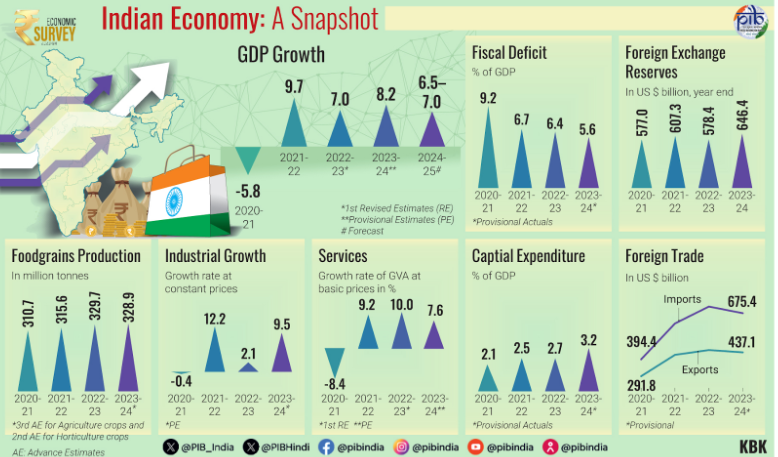
Chapter 2: Monetary Management and Financial Intermediation – Stability is the Watchword
- Banking Sector : Displayed stellar performance with RBI maintaining a steady policy rate of 6.5% .
- Credit Growth : Scheduled Commercial Banks' credit disbursal grew by 20.2% to ₹ 164.3 lakh crore .
- Agricultural Credit : Witnessed double-digit growth. Industrial credit grew by 8.5% .
- Corporate Debt : 31,394 corporate debtors disposed of, involving ₹ 13.9 Lakh Crore .
- Market Capitalisation : India’s stock market capitalisation-to-GDP ratio is among the highest globally.
Chapter 3: Prices and Inflation – Under Control
- Inflation Management : Retail inflation stayed at 5.4% , aided by price cuts on LPG, petrol, and diesel.
- Food Inflation : Increased to 7.5% in FY24 due to weather and crop issues.
- Future Projections : RBI projects inflation to fall to 4.5% in FY25. IMF forecasts 4.6% in 2024 and 4.2% in 2025.
Chapter 4: External Sector – Stability Amid Plenty
- External Sector Performance : India's rank in the World Bank’s Logistics Performance Index improved to 38th .
- Current Account Deficit : Narrowed to 0.7% of GDP.
- Exports : Services exports grew by 4.9% to USD 341.1 billion . India remains the top remittance recipient with USD 120 billion in 2023.

Chapter 5: Medium-Term Outlook – A Growth Strategy for New India
- Policy Focus : Key areas include boosting private investment, expanding MSMEs, agriculture, financing green transitions, bridging education-employment gaps, and capacity building of states.
- Growth Strategy : Requires collaboration between Union Government, State Governments, and the private sector to achieve 7% plus growth.
Chapter 6: Climate Change and Energy Transition – Dealing with Trade-Offs
- Renewable Energy : 45.4% of installed electricity generation capacity comes from non-fossil sources.
- Emission Reduction : Emission intensity of GDP reduced by 33% from 2005 levels.
- Energy Savings : Annual energy savings of 51 million tonnes of oil equivalent translate to cost savings of ₹ 1,94,320 Crore and emissions reduction of 306 million tonnes .
- Green Bonds : Issued ₹ 16,000 Crore in early 2023 and ₹ 20,000 Crore in late 2023.
Chapter 7: Social Sector – Benefits that Empower
- Welfare Expenditure : Increased at a CAGR of 12.8% from FY18 to FY24.
- Ayushman Bharat : More than 34.7 crore cards generated, covering 7.37 crore hospital admissions and 22 mental disorders .
- Education : “Poshan Bhi Padhai Bhi” program for preschool education, Vidyanjali initiative benefiting 1.44 crore students.
- Patents : Rapid progress in R&D with nearly one lakh patents granted in FY24.
Chapter 8: Employment and Skill Development – Towards Quality
- Unemployment : Rate declined to 3.2% overall and 6.7% in urban areas.
- Labour Market : Growth in EPFO memberships with a doubling in net payroll additions from 61.1 lakh in FY19 to 131.5 lakh in FY24.
- Gig Workforce : Expected to expand to 2.35 crore by 2029–30.
Chapter 9: Agriculture and Food Management – Plenty of Upside Left If We Get It Right
- Sector Growth : Average annual growth rate of 4.18% over the last five years.
- Credit Disbursal : Total credit to agriculture amounted to ₹ 22.84 lakh Crore .
- Research Investment : For every rupee invested in agricultural research, the payoff is ₹ 13.85 .
Chapter 10: Industry – Small and Medium Matters
- Industrial Growth : Supported overall economic growth with 9.5% in FY24.
- Pharma Market : India’s pharmaceutical market is the world’s third largest at USD 50 billion .
- PLI Schemes : Attracted over ₹ 1.28 Lakh Crore in investment, leading to production/sales of ₹ 10.8 Lakh Crore .
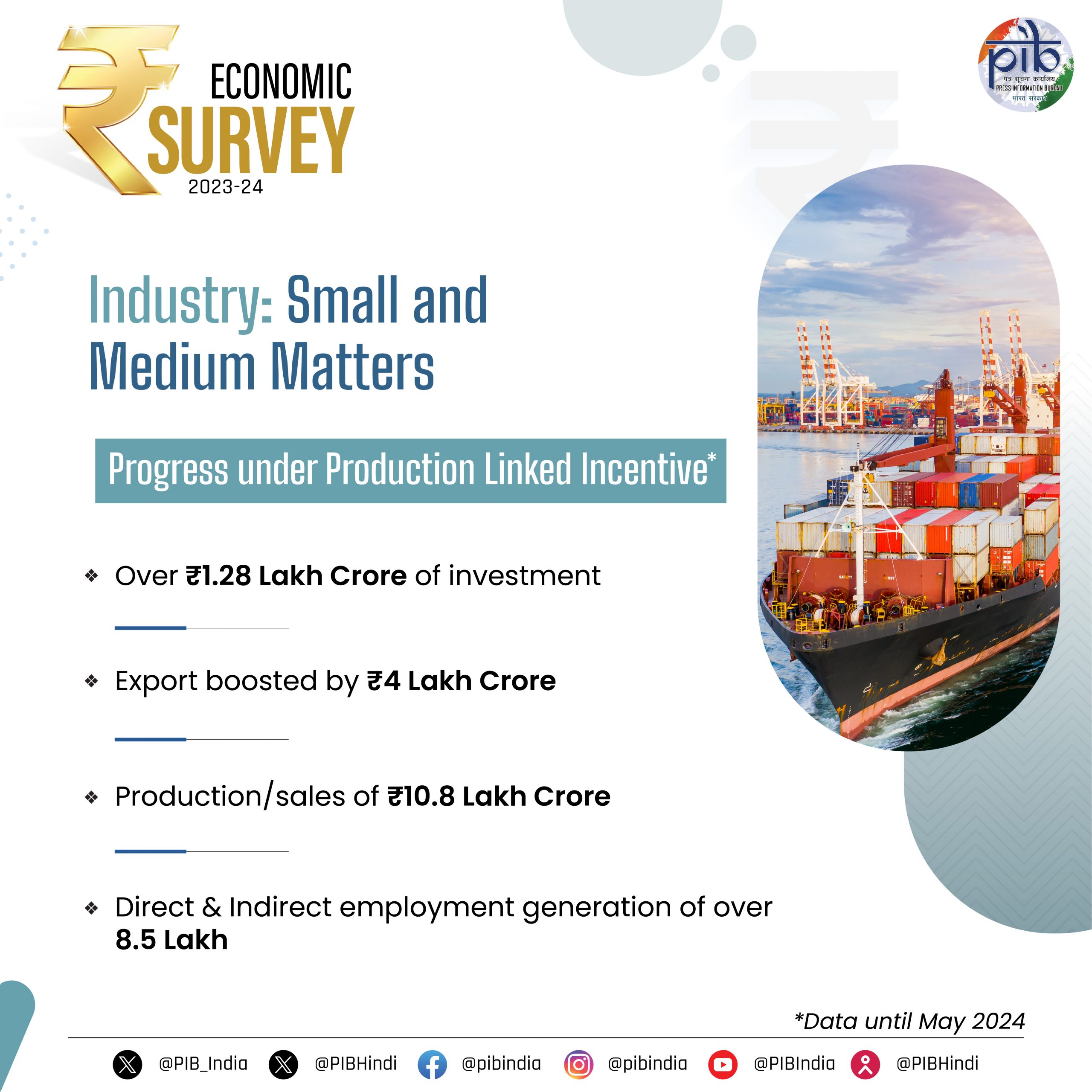
Chapter 11: Services – Fuelling Growth Opportunities
- Sector Contribution : The services sector contributes 55% to the Gross Value Added (GVA).
- Expo rt Growth : India’s share in global digitally delivered services exports increased to 6% in 2023.
- Tourism : Witnessed 92 lakh foreign tourist arrivals in 2023, a 43.5% YoY increase.
-
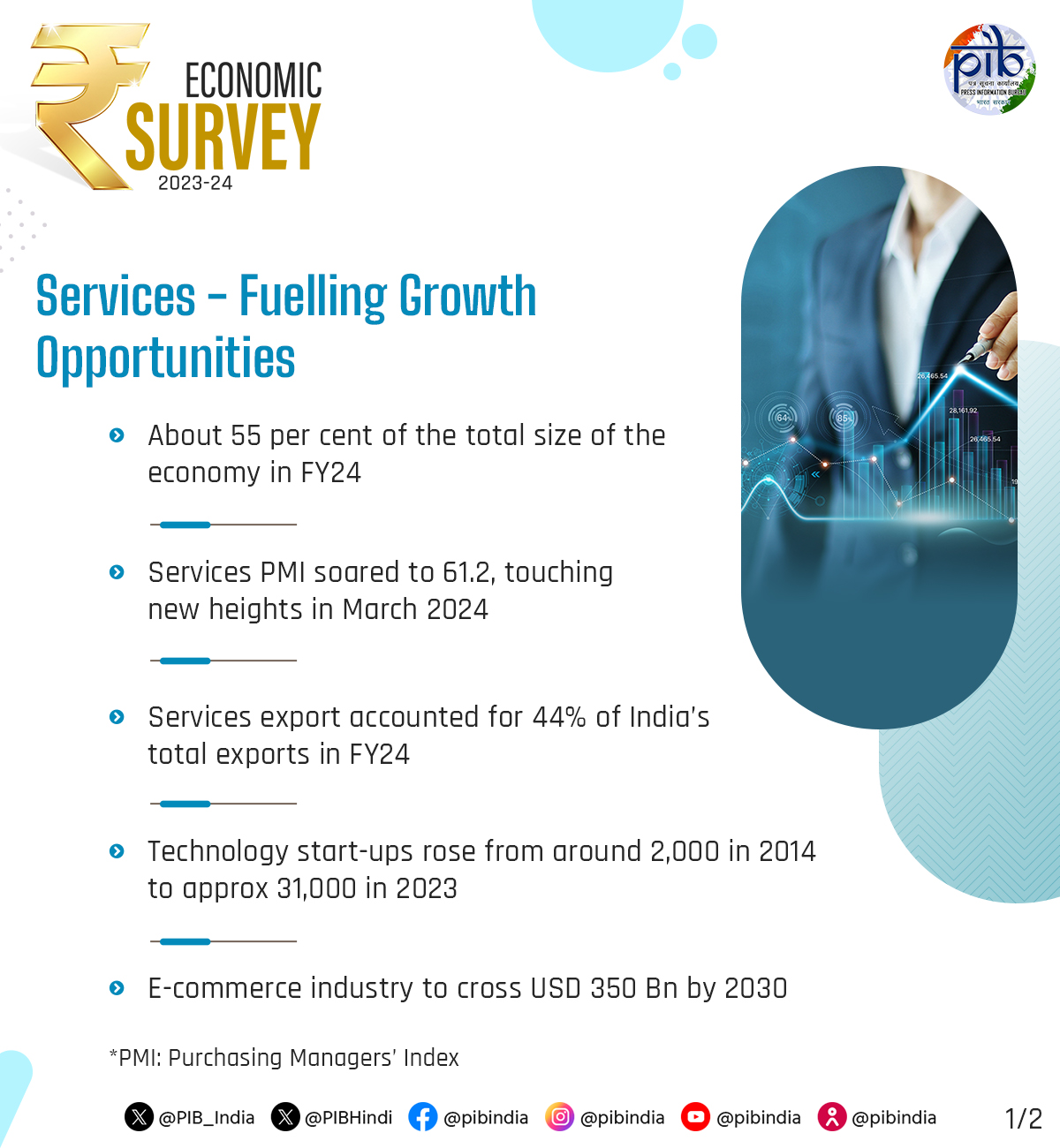
Chapter 12: Infrastructure – Lifting Potential Growth
- National Highways : Pace of construction increased from 11.7 km/day in FY14 to 34 km/day by FY24.
- Railways Capex : Increased by 77% in the past 5 years. New terminal buildings operationalised at 21 airports .
- Logistics Performance : India’s rank in the World Bank’s Logistics Performance Index improved to 22nd .
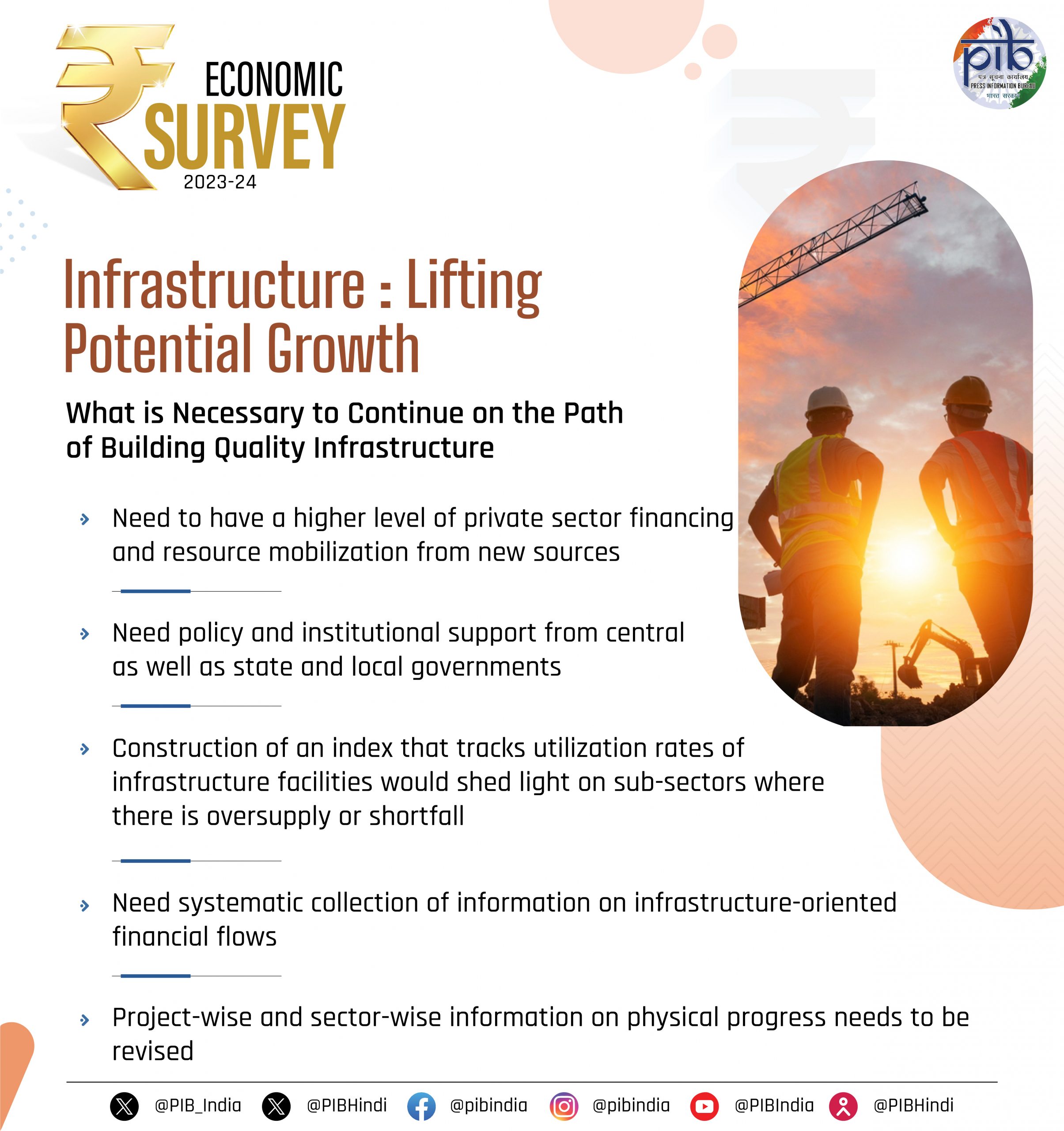
Chapter 13: Climate Change and India – Why We Must Look at the Problem Through Our Lens
- Climate Strategy : Emphasizes a harmonious relationship with nature and mindful consumption through “Mission LiFE.”
- Western Approaches : Criticised for not addressing overconsumption, advocating for a more tailored approach for developing countries.
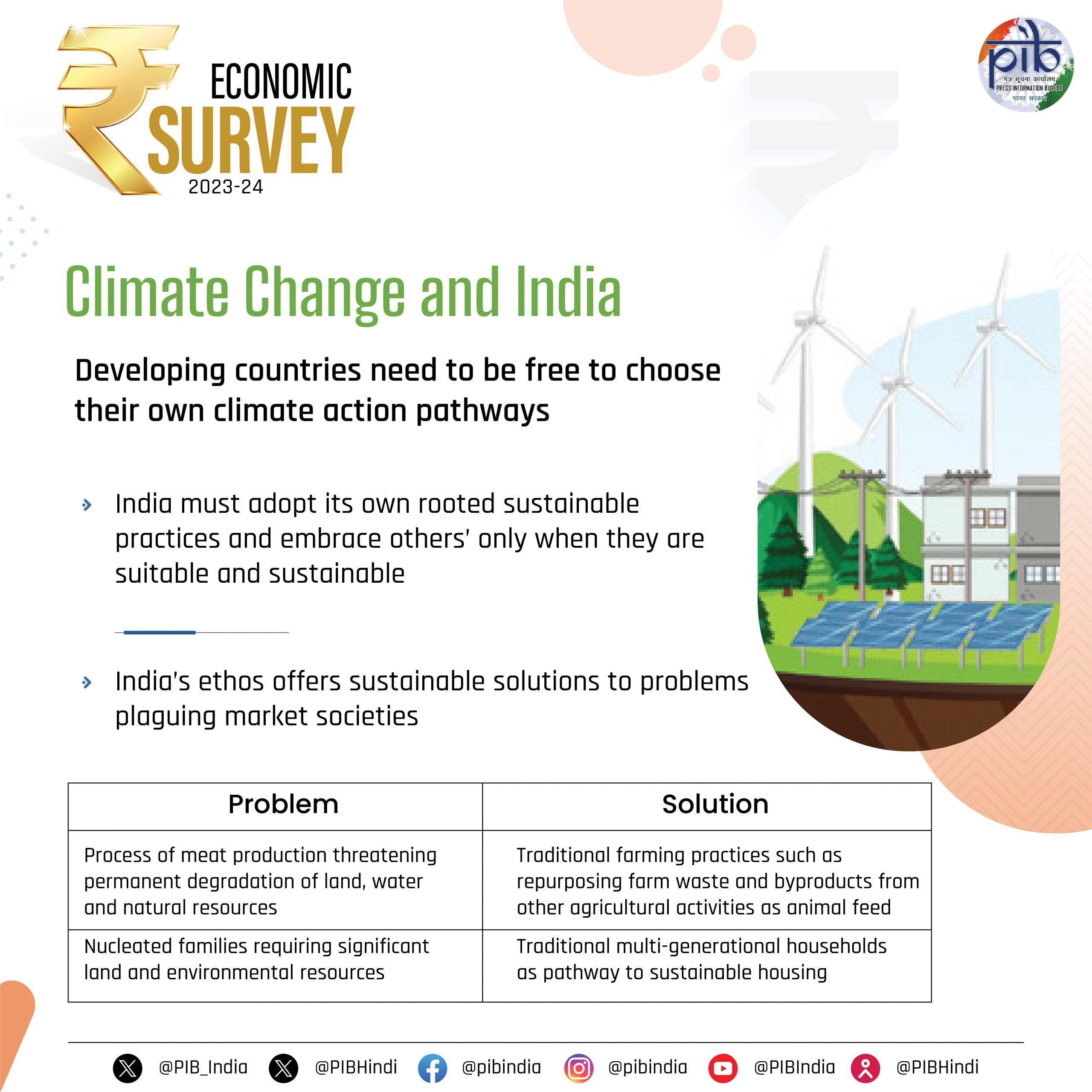
Importance of Economic Survey 2024 for UPSC
The Economic Survey holds immense importance for UPSC aspirants. It is a crucial resource for understanding the economic landscape of the country and preparing for various stages of the UPSC examination, including the Preliminary Exam, the Mains Exam, and the Interview. Candidates should read Economic Survey 2024 for UPSC is due to the following reasons:- Comprehensive Data: The Economic Survey provides a wealth of data and statistics that are invaluable for answering questions related to the Indian economy. UPSC often asks a few questions related to trends presented in the latest Economic Survey.
- Holistic Understanding: The Survey provides a holistic view of the economy, covering various sectors and indicators. This comprehensive understanding is essential for tackling interdisciplinary questions that link the economy with other aspects of governance, society, and the environment.
- Policy Analysis: The Survey offers a detailed analysis of government policies and their impact. This analysis helps aspirants understand the rationale behind policy decisions and their implications, which is crucial for writing insightful answers in the main exam.
- Essay Writing: For the Essay Paper in the UPSC Mains exam, the Economic Survey serves as a rich source of topics and content. Aspirants can draw upon the Survey's insights to write well-informed and analytical essays on economic issues.
- Interview Preparation: During the UPSC interview, candidates are often asked about current economic issues and their views on government policies. The Economic Survey equips aspirants with the knowledge to answer these questions confidently and accurately.
| UPSC Related Articles | ||
| Important Economy Topics for Mains | UPSC Optional Subject | UPSC Syllabus 2024 |
| UPSC Mains Exam Pattern 2024 | UPSC Scholarship Test 2024 | UPSC Result 2024 |
Economic Survey 2024 FAQs
When will the Economic Survey 2024 be released?
The Economic Survey 2024 has been released on July 22, 2024.
Who publishes the Economic Survey of India?
The Economic Survey of India is published by the Ministry of Finance.
How to read the Economic Survey for UPSC?
Focus on key sectors, policy measures, and economic indicators; use expert analyses by PW OnlyIAS for comprehensive understanding.
How many questions from the Economic Survey in UPSC?
The number of questions varies, but typically 3 to 4 questions might be asked in the UPSC exam.
How to use Economic Survey 2024 for Mains?
Use comprehensive data and policy analysis for to support your answers in answer writing.
Talk to a counsellorHave doubts? Our support team will be happy to assist you!

Check out these Related Articles
Free Learning Resources
PW Books
Notes (Class 10-12)
PW Study Materials
Notes (Class 6-9)
Ncert Solutions
Govt Exams
Class 6th to 12th Online Courses
Govt Job Exams Courses
UPSC Coaching
Defence Exam Coaching
Gate Exam Coaching
Other Exams
Know about Physics Wallah
Physics Wallah is an Indian edtech platform that provides accessible & comprehensive learning experiences to students from Class 6th to postgraduate level. We also provide extensive NCERT solutions, sample paper, NEET, JEE Mains, BITSAT previous year papers & more such resources to students. Physics Wallah also caters to over 3.5 million registered students and over 78 lakh+ Youtube subscribers with 4.8 rating on its app.
We Stand Out because
We provide students with intensive courses with India’s qualified & experienced faculties & mentors. PW strives to make the learning experience comprehensive and accessible for students of all sections of society. We believe in empowering every single student who couldn't dream of a good career in engineering and medical field earlier.
Our Key Focus Areas
Physics Wallah's main focus is to make the learning experience as economical as possible for all students. With our affordable courses like Lakshya, Udaan and Arjuna and many others, we have been able to provide a platform for lakhs of aspirants. From providing Chemistry, Maths, Physics formula to giving e-books of eminent authors like RD Sharma, RS Aggarwal and Lakhmir Singh, PW focuses on every single student's need for preparation.
What Makes Us Different
Physics Wallah strives to develop a comprehensive pedagogical structure for students, where they get a state-of-the-art learning experience with study material and resources. Apart from catering students preparing for JEE Mains and NEET, PW also provides study material for each state board like Uttar Pradesh, Bihar, and others
Copyright © 2025 Physicswallah Limited All rights reserved.
Get App

